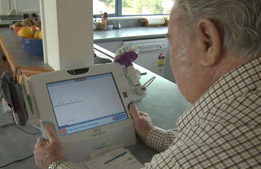Eastern Bay of Plenty case study - Telemonitoring improves quality of life

August 2017
Telehealth monitoring for people with long-term conditions shows technology can improve the quality of life and may have a positive impact on life expectancy.
- Region:Bay of Plenty
- How:Remote Monitoring
- What:Patient Monitoring
- Specialty:
- Phase:Active
 Ray Butler, who has the lung disease asbestosis, would certainly agree – he has a new sense of hope about life after learning to better manage his condition with the assistance of a telemonitor in his home.
Ray Butler, who has the lung disease asbestosis, would certainly agree – he has a new sense of hope about life after learning to better manage his condition with the assistance of a telemonitor in his home.
Ray was a client of Te Whiringa Ora/Care Connections (TWO) – a community-based integrated support service in the Eastern Bay of Plenty from Healthcare of New Zealand.
TWO works with other health and social services to provide a web of care around clients (and their whānau) with multiple long-term conditions, and those who are high users of hospital services, so they can remain active in their homes and community.
The telehealth monitors enable patients to take their own vital sign measurements, including their blood pressure, blood sugars and lung capacity. These measurements are then assessed remotely by nurses, enabling medical teams to detect changes early, before the person develops a serious issue that needs hospital treatment. Just as importantly, the monitors reinforce the client’s ability to self-manage their condition, a philosophy on which the TWO model is based.
Initially, Ray Butler was uncertain about the technology. ‘When I started, I hadn’t had anything to do with computers, but after a bit of coaching, I soon mastered it.
‘The condition hasn’t changed…but now with help, I feel I’ve got it under control and it’s not so scary. I feel I can stay out of the hospital and feel quite confident about the future.’
Ray Butler is just happy to enjoy his new lease of life.
‘When you have to go to the hospital so many times, you can’t help but get that feeling that time is running out. Now that (my asbestosis) appears to be under control, and that I've got control, I’ve got a different outlook.’
